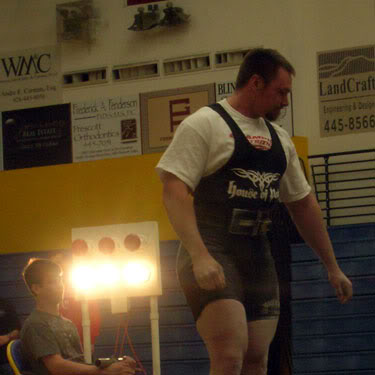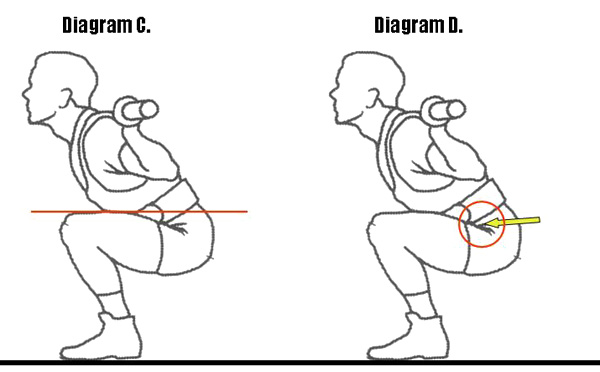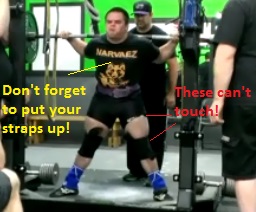The squat is the first lift performed at every single powerlifting meet. The squat itself isn’t too complicated; you strap on your powerlifting belt, you squat down with a heavy weight and then you stand back up. The rules don’t have to be too complicated, either. Let’s make sure your squats count.
This article isn’t about technique, but if you’re trying to figure out how to optimize your squat leverages, check out the technique series.
Judges and White Lights
As a brief aside, I need to note that, during any lift, competitors are overseen by three judges. It is each of these judges’ job to pay close attention to whether or not the lifter complies with the rules of the event. If a given judge believes that you have, he will flip a switch awarding you a “white” light; or, if he believes you have not, you’ll receive a “red” light. So long as you get at least two white lights, your lift will count.

In Powerlifting, three white lights means all three judges agree your lift was legal and good.
Photo Credit:Brandon Cox
Execution
First, the announcer will let you know that you’re up. Your “turn” officially starts when the announcer calls out, “the bar is loaded”. You have exactly one minute from the time this announcement is made to set-up and unrack the bar. If you fail to do this in under a minute, you forfeit your attempt.
After you unrack the bar, you need to set-up to squat. For those of you squatting out of stands, you’ll have to walk it out. For monolift users, you’re good to go as soon as the spotters clear the hooks. When you’re all set-up and ready to squat, make sure you stand straight up and fully lock your knees out. Once you’ve done this, make eye contact with the head referee. He will then give you the “Squat!” command which is analogous to a “start” signal, but you can begin the actual movement at your own leisure. Be warned, you will not receive the squat command if your knees aren’t fully locked or if you aren’t standing straight up.
After you’ve received the squat command, you need to squat down until your hip joint drops below your knee joint. After you’ve hit depth, squat the weight back up. Make eye contact with the head referee again and wait until he gives you the, “Rack!” command. Once you get the command, you’re allowed to return the bar to the rack.
For a real world example of this whole process, see the video at the end of the section, “Technical Rules”.
More on Squat Depth
Not reaching legal depth is by far the most common technical reason that lifters fail squats. Nearly every federation’s rulebook contains approximately the same rule. Here is the definition of depth from the IPF Rulebook:
“…the lifter must bend the knees and lower the body until the top surface of the legs at the hip joint is lower than the top of the knees.”
In simple terms, this means the lifter must squat down until their hip joint is lower than their knee joint.
Unfortunately, depth standards are not universal. Some federations have a reputation for over-enforcing the rule and others are notorious for the exact opposite reason. If you’d like a video example of legal depth, or if you’d like to hear a bit more about the politics of squat depth in powerlifting, I highly recommend that you watch this video:
Technical Rules
You can fail the squat for a variety of reasons:
- As mentioned above, the most common error is not reaching legal depth. This will automatically disqualify your lift even if you successfully complete the attempt.
- If you do not follow the commands, your lift will be disqualified. You must wait for the “Squat!” command to begin your descent and you must wait for the “Rack!” command to return the bar to the rack. If your feet move at all during or after the lift, and before you’re given the “Rack!” command, the squat will not count. Ray Williams just missed a 950 raw squat because of this.
- If at any time during the lift, the bar moves downwards, on either side, or both, the lift will be disqualified. The bar can stall in a certain spot, but it may not move downwards.
- Also, please note that if you choose to dump the bar, either over your head or off of your back, you will likely be disqualified from the event entirely. If you start to fail, ask the spotters to help and STAY WITH THE BAR. I’ll say it one more time: dropping the bar is grounds for complete disqualification from the contest.
Watch this video for some real world examples of each of the above rules:
Equipment Rules
There are also a few equipment considerations. Your knee sleeves, or knee wraps, may not touch your singlet or the lift will not count. You must have the straps of your singlet up when you step onto the platform. I almost lost a squat opener because of this rule. Luckily, I walked away with only a warning. Remember, your shoe heels can’t be taller than two inches. Refer to Part II for more on powerlifting shoes.
If you don’t already have one, make sure you grab a legal powerlifting belt. For all squats, a good powerlifting belt is critical.
Like this Article? Subscribe to our Newsletter!
If you liked this articled, and you want instant updates whenever we put out new content, including exclusive subscriber articles and videos, sign up to our Newsletter!
Questions? Comments?
[contact-form-7 id=”3245″ title=”Contact form 1″]
The Guide to Powerlifting Rules: Table of Contents
Part I: Powerlifting Equipment
Part II: Gear
Part III: The Squat
Part IV: The Bench
Part V: The Deadlift
Part VI: Powerlifting Federation Reference Guide
Bonus: How To Pick The Right Federation

